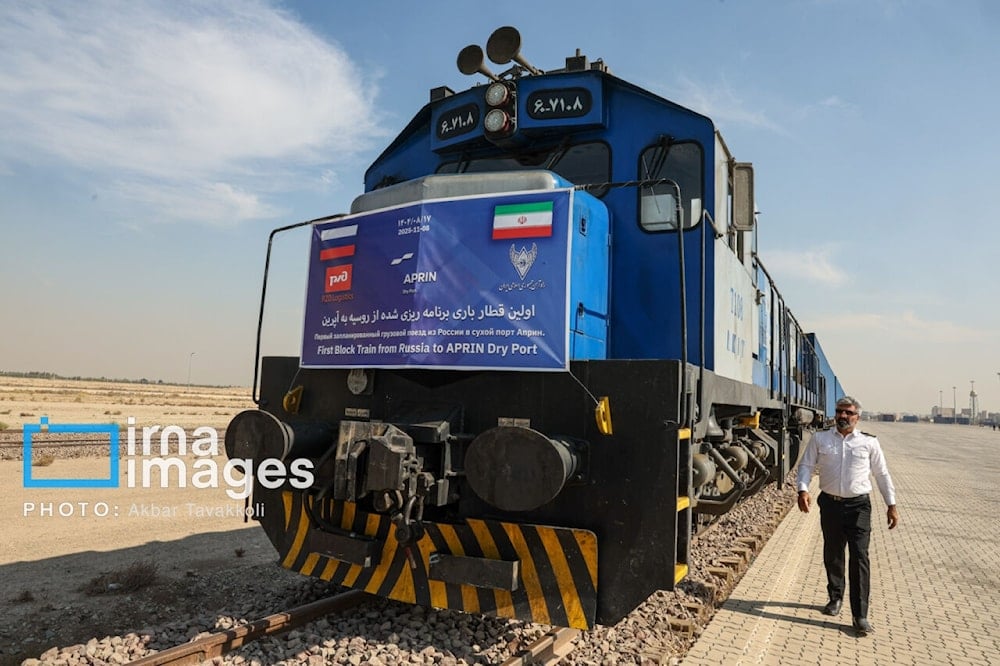Iran’s Aprin dry port receives first Russian freight train
Iran’s Aprin dry port has received its first scheduled Russian freight train, a 62-container consignment, marking a milestone for INSTC rail links.
-

A freight train stands at Iran’s Aprin Dry Port after completing its journey from Russia on November 8, 2025, as railway official walks alongside it (IRNA)
The first scheduled freight train from Russia arrived at Iran’s Aprin dry port on Saturday, Iran's Islamic Republic News Agency (IRNA) reported, marking a milestone in efforts to expand regular rail links between Iran, Russia, and Central Asian neighbours.
The service, a 62-container train carrying paper, pulp, and related goods bound for Iran and Iraq, completed a 12-day transit after departing roughly 900 kilometres north of Moscow and passing through Kazakhstan and Turkmenistan to enter Iran via the Incheboron crossing.
IRNA described the arrival as the product of intensive coordination between railway authorities, customs offices, rail forwarders, and cargo owners along the route and hailed it as a key advance for the International North–South Transport Corridor (INSTC).
Morteza Jafari, deputy for commerce and operations at the Islamic Republic of Iran Railways, told IRNA that since June, when the first train from China reached Aprin, 30 trains have arrived at the facility, and that expansion work is underway.
“Through coordination with other regional and CIS countries, we are working to make Iran a hub for exports, imports, and transit among neighboring states,” Jafari said, referring to the Commonwealth of Independent States, an intergovernmental organization in Eurasia.
First scheduled freight train from Russia arrives at Iran’s Aprin dry porthttps://t.co/grNOhAwsV6 pic.twitter.com/vyt8LP6LKL
— IRNA News Agency (@IrnaEnglish) November 8, 2025
What is the INSTC?
The International North–South Transport Corridor is a multimodal network of rail, road, and maritime links designed to connect South Asia and the Persian Gulf with Russia, Central Asia, and northern Europe through Iran. Conceived as an alternative, shorter route for freight between the Indian Ocean and northern markets, the INSTC seeks to lower transit times and costs by bringing together ports, railheads, and overland corridors under coordinated customs and operational arrangements.
Why now?
Officials involved in the Aprin operation point to growing commercial demand for diversified routes, increased regional cooperation, and practical efforts to improve logistics capacity as the drivers of expansion. The inauguration of regular services from multiple origins, including China and now Russia, reflects both private-sector demand and state-level efforts to operationalize long-discussed corridor projects. The timing also corresponds with intensified coordination among rail and customs agencies across the route, enabling scheduled services to run more reliably.
Read more: Tehran, Moscow to finalize INSTC rail project next month
Why is this significant?
Beyond the symbolic value of the first scheduled Russian service, the shipment demonstrates the corridor’s operational viability over a long, multi-jurisdictional route. A successful 12-day transit carrying 62 forty-foot containers signals that complex cross-border procedures and technical handoffs can be managed at scale, a precondition for turning occasional shipments into regular, higher-volume services.
How the INSTC affects Iran and Russia
For Iran, expanded INSTC traffic promises to strengthen its position as a transit hub, generate customs and logistics revenues, and deepen trade links with neighbouring markets. For Russia, an overland route through Iran and Central Asia offers an alternative corridor to reach Middle Eastern and South Asian markets, potentially shortening delivery times compared with longer maritime routes.
Both states can benefit from lower transport costs, increased market access, and strengthened regional connectivity if services scale up.
The Rasht–Astara railway, the last major rail gap
In this context, the completion of the Rasht–Astara railway would be a strategic complement to Aprin and the broader INSTC by filling the last major rail gap on the western corridor. Once finished, the Rasht–Astara link would enable uninterrupted rail movement from Azerbaijan and Russia through northern Iran to the domestic network, removing the current need for truck transfers or circuitous detours across short, missing segments.
The railway would consolidate Iran's role as a transit hub by creating a continuous north–south axis that connects Caspian links to ports on the Gulf and the country’s interior logistics centres such as Aprin.
It would also reduce handling costs and transit times, increase throughput at inland terminals, and generate customs and rail revenues for provinces along the route, especially Gilan and Ardabil.
Together, a functioning Rasht–Astara link and growing Aprin throughput could lock in the INSTC’s potential as a competitive alternative corridor.
Read more: Iran, Pakistan agree on new transport, customs cooperation

 4 Min Read
4 Min Read










